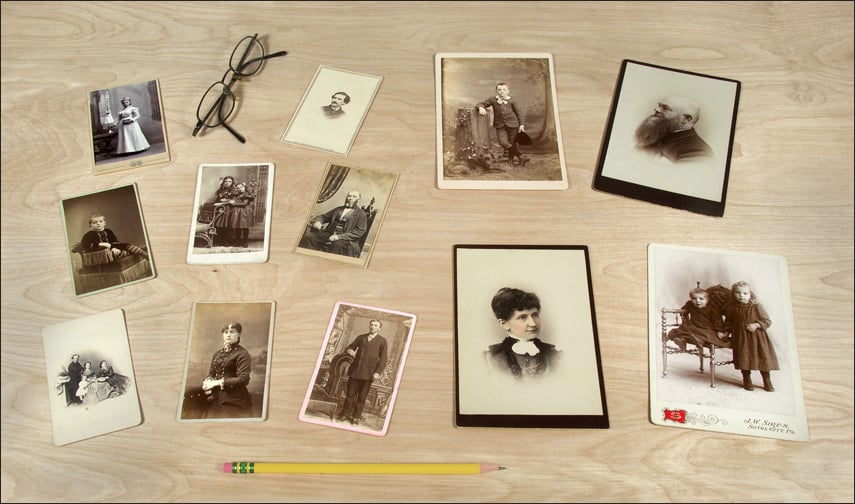Two of the most popular forms of 19th century photography you may have in your family archive are cabinet cards and cartes-de-visite (the latter is French for “visiting cards,” and will be shortened to CDVs throughout this article).

Formal photographic portraits in these two formats were quite the craze in the years before the introduction of amateur cameras. Created by local professional photographers, individuals would often order multiple copies of these wonderful images for distribution to family and friends when visiting.
The small carte-de-visite, introduced in France, became hugely popular on both sides of the Atlantic between roughly 1859 and the early 1870s. It was eventually supplanted by the larger cabinet card beginning in the 1870s, and finally disappearing with the advent of inexpensive Brownie cameras and other forms of snapshot photography around the turn of the 20th century.


Now let’s take a look at how you can archivally preserve these photographic records of your family history.
Scanning Cabinet Cards and CDVs
Cartes-de-visite are rather small, measuring only 2-1/2″ x 4″, while cabinet cards usually measure 4-1/2″ x 6-1/2″. Both of these types of images can be archivally stored in a number of museum-quality acid-free materials, but we recommend scanning them first.
Scanning your CDVs and cabinet cards will allow you to print and work with high-quality scans instead of the often one-of-a-kind original photographs, which you’ll be archivally storing in the steps below.

While cabinet cards are the larger of the two formats we’re discussing, even the smaller CDVs hold a tremendous amount of photographic detail, which will allow you to enlarge and print scans of even the smallest images for your photo album and to share with relatives. You can also use your phone to make digital copies if you don’t have a scanner.


If there is information written or printed on the back of your CDVs or cabinet cards, consider scanning it too, as this information may help you to discover who is in your photographs and when and where it was taken.


Archival Storage
The use of various inexpensive acid-free enclosures will help prevent dust, finger oils, or moisture from coming into contact with your images during handling & storage.


Another way to store these one-of-a-kind images is to place them in Crystal Clear Bags with a sheet of Acid-Free Card Stock added for additional rigidity and support (4-1/4 x 6-1/8” for CDVs and 5-1/4 x 7-1/8” for cabinet cards). You can also write important identification information on the card stock with an archivally-safe pencil or marker.
Once your photographs are securely stored in archival enclosures, store them in acid-free Metal Edge Boxes for easy access and safe long-term storage. All of your 19th-century cabinet cards, cartes-de-visite, tintypes, postcards, and other photographs can be organized and stored in convenient museum-quality enclosures and acid-free boxes.

Binder Storage for an Archival Photo Album
You can also integrate your irreplaceable CDVs and cabinet cards into your photo albums by placing them in Print Pages. Note that a pre-cut sheet of Acid-Free Card Stock has been added to each Print Page pocket for added stability and support.

These Print Pages can then be placed in any of our many styles of archivally-safe binders.

Using sheets of Acid-Free Card Stock behind your images in your Print Pages will also allow you to write identification information with archivally-safe pencils or markers.
Protecting Antique Albums
There were a number of different 19th-century album designs that accommodated cabinet cards and CDVs. If you have one of these, consider scanning the images within and then archivally storing the actual album.


If the spine allows, you can interleave the pages with Archival Buffered Tissue. This adds some protection to the images. Place the photo album into an archival Polyethylene Bag or wrap it in archival paper or tissue and then into an acid-free Metal Edge Box. Check out our Book Storage Kit options or order a la carte from our different sizes and designs of archival boxes.
Framing & Displaying Vintage Prints

If you have an image that you want to mat and frame, consider using an 8-ply mat rather than a standard 4-ply mat, as photographs on cards have a certain depth and you don’t want the image surface to come into contact with the frame’s glass or glazing. In the photo above, the cabinet card is being “floated” in the center of the mat in order to show the entire image.
When framing and displaying artwork, especially one-of-a-kind original works, use UV-filtering glazing (glass or acrylic). Also, be sure to hang it out of direct sunlight and away from fluorescent lighting.
In closing, we hope you’ll contact us here at Archival Methods if you have any additional questions on how best to preserve and share your cartes-de-visite and cabinet cards.
Click here for more information on cartes-de-visite, and click here to learn more about cabinet cards.




